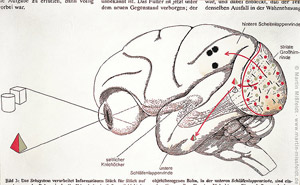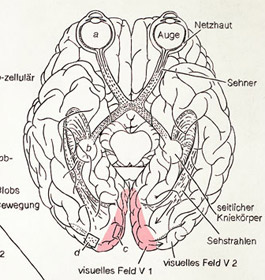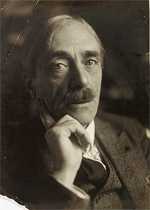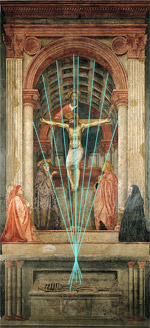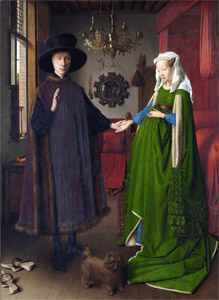Introduction: What is the perspective?
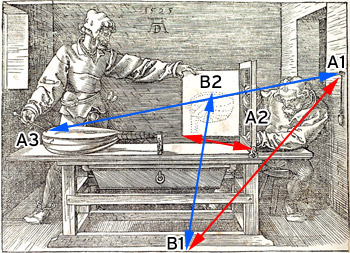
"The Draughtsman of the Lute" by Albrecht Duerer (1525)
Two perspectives in one woodcut:
Viewer and construction of the viewer
"Item Perspectiva is a Latin word, meaning a view-through." This is how Duerer tried to paraphrase the term perspective..." ... This is how Erwin Panofsky introduces his essay "Perspective as a symbolic form". In fact, it makes the most sense methodically to first delimit the phenomenon conceptually by following the Panofsky definition: "... We want to speak, and only there, of a "perspective view of space" in the full sense, where not only individual objects, such as houses or pieces of furniture, are represented in a "shortening", but where the whole picture [...] has transformed itself into a "window", as it were, through which we are supposed to look into the space - in other words, where the material surface of painting and relief [...] is to be seen....] is reinterpreted into a mere picture plane, on which one and through which one sees oneself and all individual objects are projected into a comprehensive overall space - whereby it does not matter whether this projection is determined by the immediate sensual impression or by a more or less "correct" geometric construction.
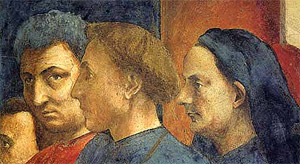
Masaccio, Alberti and Brunelleschi (f.l.t.r.)
Detail from the fresco
"The Resurrection of the Son of Theophilus"
Brancacci Chapel in Florence
The "View-through" (after Duerer) is therefore to be understood as a "window view". This formulation also corresponds to that of Leon Battista Alberti, who wrote down his findings on perspective in 1426 in the treatise "De Pittura" (on the art of painting). A few years earlier Filippo Brunelleschi had, in the opinion of many art historians, created the first perspective picture panels of modern times (1410). He influenced Masaccio, among others, who created some wall frescoes according to the perspective method. This also includes the Brancacci Chapel in the Florentine church of Santa Maria del Carmine, painted in 1424 by Masaccio and his teacher Masolino. "This work is so grandiose, so expressive and so subversive in perspective, colour, expression and attitude that even centuries later the young painters and sculptors (like Michelangelo) will pilgrimage to Carmine Church to study there. Source: Wikipedia.
Excursus: Seeing the world with the eye
Regardless of whether it is a "look through" or a "window view" or an "average pyramid of sight" (Alberti) - all definitions of perspective have one thing in common: seeing. Understanding the meaning of perspective requires a scientific digression. Does seeing function perspectively?
According to today's scientific theory, seeing works in principle like this (roughly simplified): The light of the sun is reflected by the environment surrounding us. The photons race as light rays in all directions, and some of them fall into the eye. There it is converted by photoreceptors in the retina into electrical impulses, which then take a very complicated path: in various processing steps the information is bundled, summarized and structured.
Seeing is therefore NOT the absorption of light information in the eye, but the entire processing process.
In the end, the structured information is transmitted to the brain, where it is combined with other sensory information before it settles on huge brain areas and thus embodies our visual image of the world. So our visual image of the world is not reality in itself, but what is filtered out by the evolutionary process of processing. In the context of perspective, it is of course important to mention that light always hits the eye in a straight line.
Stereoscopic vision - the world is 3D
The world in which we live is naturally a three-dimensional one. Our entire physical experience is based on the fact that we are in a space and can move. However, the retina is only two-dimensional (though curved). But nature was smart: it gave us two eyes that allow "stereoscopic vision". So we always see the world from two perspectives. As mentioned before, this information is then bundled and combined so that we have a three-dimensional picture of the world.
According to current scientific knowledge, the processing mechanisms of the eye are based on textures, invariances and motion. The term "perspective" does not appear. Perspective perception seems to be irrelevant for sensory processing.
Images are 2D
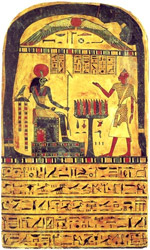
Egyptian Painting
Source
The perspective in its "meaning of looking through" is based on a phenomenon that was originally only inherent in images: two-dimensionality. Perspective is an "invention" (not a "discovery"!) oriented towards the visual mechanism to simulate our three-dimensional visual experience on a two-dimensional background. Perspective vision is a learned process that is not insignificantly connected with perspective images. This is the only way to explain why so many cultures and epochs managed completely without perspective images. This is how B. Schweitzer in his essay "The sense of the perspective" (1953) states: "Infinite earth and time spaces are filled with an unperspective art".
I see myself seeing myself!
There is a considerable step between the picture itself and the perspective pictures: the invention of depicting seeing itself. Our consciously controllable gaze is no longer that of "pure" seeing (i.e. for the sake of survival), but that of seeing consciously can also be called "visible seeing". Or as Paul Valery remarks: "I see myself seeing myself!
The artistic intention is thus enriched by one theme: the conscious representation of what one sees. This seems so self-evident to us today - above all because the two-dimensional world of images is increasingly displacing the real world. At the beginning of the Renaissance, the invention of perspective was a sensation.
The meaning of images
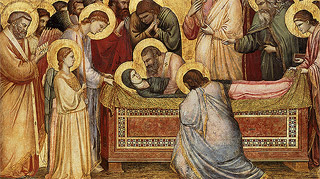
Medieval altar painting by Giotto (detail)
Previously, two-dimensional images served primarily social-religious purposes. Why should what you see be captured in a picture? The intention before was to create "magical" images. It made much more sense for medieval artists to create images that were somewhat different, much more (!) than just the reality seen. By the way, the same applies to most non-European cultures.
The picture on the left shows a detail from "The Death of Mary" (around 1310) by Giotto di Bondone. The halos still cover the room and the figures.
The Invention of Perspective in Antiquity
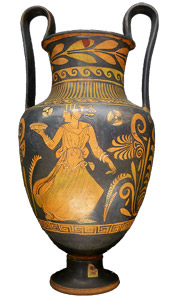
Greek vase painting
Ganymede painter, Source
From an art-historical point of view, like so much that changed the world at the beginning of the Renaissance, has long since been invented in antiquity. This also applies to the perspective. The Greek artists of the early 5th century B.C., with their increasing self-confidence and their (since Homer) humanized round dance of gods, invented the representation of the social-religious as something seen, as something of this reality. At the same time, however, this vision did not initially refer to a spatial illusion in the sense of a window view (according to Panofsky), but merely to the physical representation of figures and objects. It was a form of "body perspective" (B. Schweitzer). The artistic methods for the depicted plasticity were the (observed) shortening (e.g. with arms or weapons) and superimposition (e.g. with robes or legs).
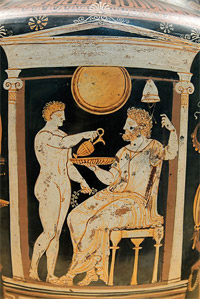
Greek vase painting
Source
At first, only the bodies were worthy of representation, not the surrounding space, which was inferior as mere "in-between" (Plato). It is certainly no coincidence - to exaggerate - that the pictorial works from this period are almost exclusively vases (or their fragments). A vase has no left or right, no middle or side. They offer no visible space, they are not part of a frozen reality.
The illusionistic backdrop
On this basis, the Greeks developed a different form of pictorial work, which, however, have been handed down to us mainly from Roman antiquity: the illusionistic backdrop. The Greek theater gave rise to the "stage design", which, in the background, functioned only as a backdrop, the Skenographia. This "inferior illusion of this world" of houses, for example, was not a work in itself, but merely a decorative accessory.
Based on this, illusionistic wall frescoes were created, which are known to us mainly from Roman villas. These are works of art in an interior that imitate a view into an exterior space.
Painted windows in Roman villas
According to Panofsky's definition, it does not matter whether the illusionistic window view is observed or constructed. According to this, one can speak of the first truly perspectival pictures in the wall paintings in the Roman villas.
The Romans probably already knew a construction method, but not a central perspective, which only crystallized in the Renaissance, but an "angular perspective". This is not based on a flat window average, but rather on the concave arched inner eye. The vanishing points of these pictures are usually distributed along a vertical axis. By the way, Damianos already defined "Skenographia" in the second century A.D. as a part of "Optics" that "examines how the reproduction of buildings in painting must be structured".
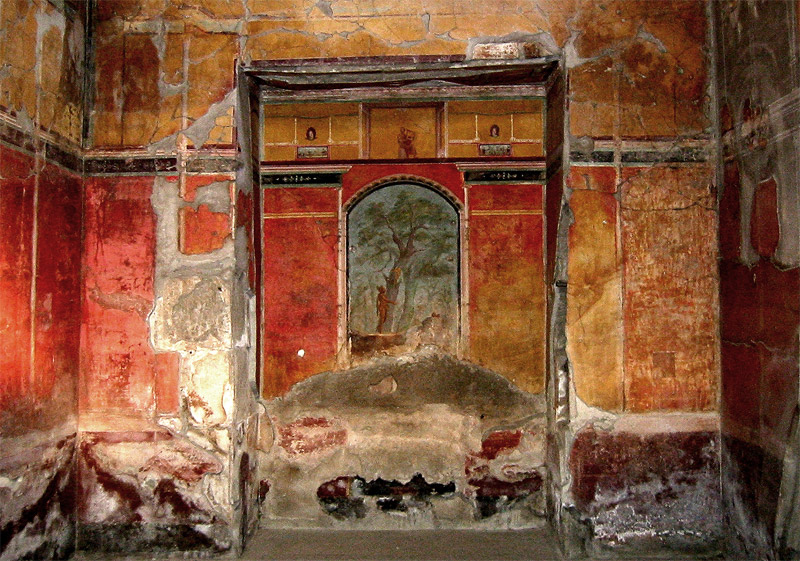
Roman mural painting in the Villa Oplontis -
Illusion of a window view: a satyr in the garden under trees (Source)
The invention of the vanishing point perspective at the beginning of the Renaissance
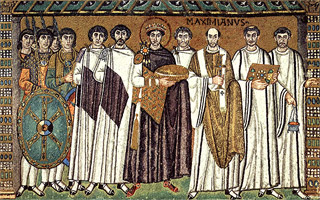
Byzantine Mosaic: Emperor Justinian (Source)
Mosaic in the church San Vitale in Ravenna
After the Roman artists had already created illusionistic mural paintings and thus perspective pictures, the perspective was forgotten in the emerging Middle Ages. The ancient representation of (observed) plastic bodies with an "inferior" in between was adopted by the Eastern Roman artists. It manifested itself in the Byzantine mosaics. In the Western Roman culture there was a radical break with the previous tradition of representation. Building on the Christian philosophical metaphysics of light, a purely planar form of representation developed. The pictures now emerged from the line - the surfaces formed by lines were of equal value. The loss of all spatiality led to the fundamental unification of figure and ground.
"Figure and ground" becomes "body and space"
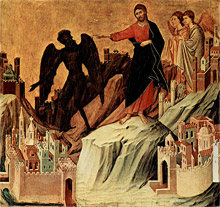
Duccio, "The Temptation of Christ."
Altar retable around 1310 (Source)
The decisive step at the end of the 13th century was the renewed separation of figure and ground. Giotto and Duccio in particular deserve the credit for having transformed "figure and ground" into "body and space". At the beginning of the Renaissance, a changing world view with a new role for man led to the need to invent new images. This newly developed process was able to visually construct any imagined reality. "A logocentric rationality has defined the (two-dimensional) question of representation (of space) as the rational manner of construction." (from "Zur Perspektive als konstruktivem Prinzip" by Peter Weibel, 1990).
In the illustration on the left, pay attention to the construction of the urban architecture in the foreground (click on the picture to enlarge).
The Trinity of Masaccio
This change, which again focused on "visible vision", brought about the qualitative equal treatment of figure and space in contrast to antiquity. This equal treatment presupposed an idea of the equality of the represented, and the idea of a geometricizable reality led to the invention of a mathematically justifiable construction method. The Lorenzetti brothers were the first to invent a vanishing point, according to Panofsky. The best known of the early, strictly constructed pictorial works is Masaccio's fresco of the Trinity. Building on this one vanishing point, which was the counterpart of the observer's eye point, it was Brunellesci who was the first to create a general construction method that made any space constructible with a ground plan and elevation drawing. And it was Alberti who finally generalized the mathematically theoretically exact derivation of the visual pyramid average with his "Trattato della pittura" (treatise on painting, 1436).
(Picture right) Wikipedia says: "The Trinity is a fresco in the church of Santa Maria Novella in Florence. It was created between 1425 and 1428 by Masaccio. It is considered groundbreaking for European art because it was the first time in painting that an artist correctly applied the laws of perspective". (Source)
Perspective conquers European art
North of the Alps, the "conquest of this new point of view" took place more slowly than in Italy. It was mainly Jan van Eyck who helped this process to break through. In addition to Jan van Eyck, Paolo Uccello and Piero della Francesca are particularly noteworthy here. In his manuscript "De prospectiva Pingende" (1470), the latter once again summarized the rules of perspective.
The new perspective construction method was accompanied by a completely new understanding of the world. Body and space became a geometrically calculable and constructible homogeneity, the "aggregate space" became the "system space". This led to an "objectification of the subjective" (Weibel), and subsequently to a "divine" ideal space, which could be represented on pictures.
As a result, numerous technical innovations developed, which also had a considerable influence on the production of art. In addition to oil painting, the printing press, the shift from the Ptolemy world view to the Copernican world view, as well as the Reformation and Counter-Reformation were also mentioned. All this had a considerable influence on the visual worlds of the artists. However, all styles and epochs since the Renaissance had one thing in common: they used perspective.
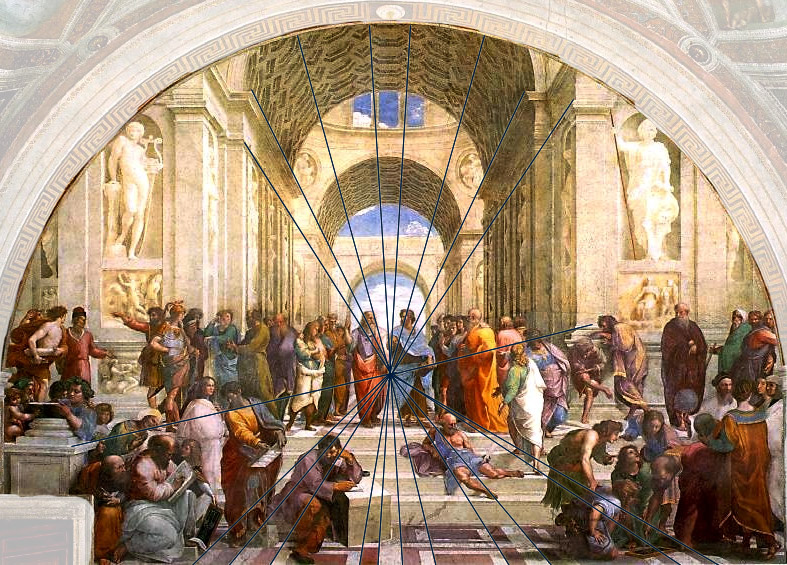
Raffael: The School of Athens (1510/11) Rome, Sistine Chapel - Central Perspective Composition
The disappearance of the perspective from art production
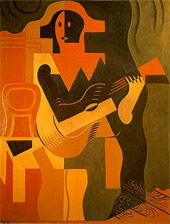
Juan Gris: "Harlequin with
Guitar", 1919 (Quelle)
With the invention of the photography, the perspective slowly disappears from the artistic images. The representation of seen reality now becomes the task of photography. Painting turned to new shores - the beginning of classical modernism and the search for abstraction gets in the focus. L'art pour l'art was born. But this is another article ;-)
After this excursion into the art-historical development of perspective, one thing seems to me above all to be worth considering: the reality of man has always been three-dimensional. For a long time pictures were "art pictures" - created by artists and a special visual challenge for the perceiving people. Meanwhile we are flooded with images. The entire digital world manifests itself in two dimensions - be it on TV, PC screen or in mobile devices. Perspective as a constructive principle is increasingly being forgotten.
More articles about perspective
- Perspective [1]: perspective drawing with vanishing point and vanishing lines
- Perspective [2]: Analysis of Duerers woodcut "The Draughtsman of the Lute"
More Tutorials
- ...
